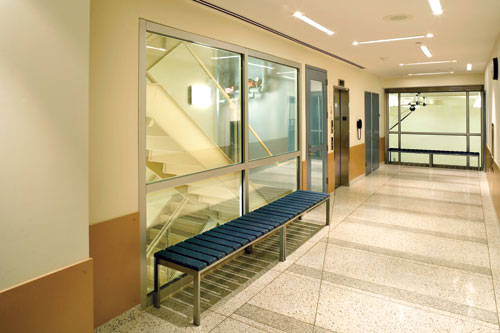Can Existing Schools Get to High Performance? An Update on School Modernization Strategies
Not without Impact: Fortunately, the increased fire/heat resistance in new safety glass technology comes along with impact resistance, too. But that's not true of all fire-rated glass.
Consumer Product Safety Commission 16 CFR 1201A is the federal safety glazing minimum standard established in 1977 to protect against accidental impact with glazing. Two categories were established. Category I is for small glazing areas (less than 1,296 inches). This glazing is meant to survive an impact of 150 foot pounds, which sounds substantial but in real life is comparable to impact from a small child (foot pounds do not equate to actual pounds). Category II, for larger glazing areas, must survive an impact of 400 foot-pounds, or the weight of an adult. (Just for context, the force of a running teen-ager has been estimated at about 1,500 foot-pounds.)
It's easy to see how the fire ratings and impact ratings are both critical in an emergency. For example, fire rated glass lining a school corridor may not afford sufficient impact protection for a large group of jostling, probably frightened, ninth graders being evacuated from a fire. For safe egress in a school, or in areas of high traffic and exposure to all but the smallest children, the glazing used in these areas must meet CPSC impact standards. Fire safety and impact safety are not separate goals − you must maintain both.
But even apart from emergencies, interior glass that is not adequately impact resistant can present a constant cost as well as danger. According to NCEF, in many schools, glass replacement is the highest routine maintenance cost.
 |
In the Reece School in New York, NY, abundant light reaches interior spaces during normal use, but egress is protected by fire resistive and impact resistant high performance glazing. Photo: SAFTI FIRST |
Daylighting and Design Flexibility. Although a school building could hardly be very "high performance" if it didn't offer occupants protection from fire and impact, there's another aspect to selecting safe interior glass for a school improvement project. The ability to use clear, fire rated glazing in applications where brick walls or sheet rock might have been used gives architects an opportunity to combine increased transparency, visibility and maximum fire safety in designs for interior glass in classrooms, interior corridors, study areas, libraries, laboratories and other areas where getting daylight into interior spaces or maximizing artificial light between shared spaces are integral parts of high performance.
Designers should also be aware that a wide range of other products are available that can replace unsafe wired glass in schools and still provide fire and impact safety, including a certified field filming program that can upgrade existing unsafe wired glass to a CPSC Category II impact safety rated product. This program can be a safe and cost effective means of achieving compliance within tight budgets. The important thing to know about field filming, however, is that it must be performed to exacting standards by a fully certified provider in order to be compliant.









